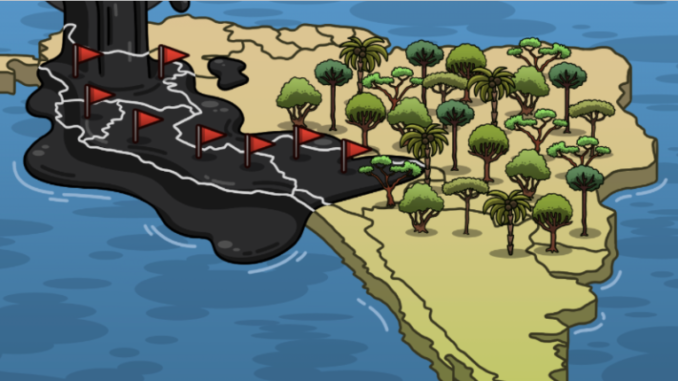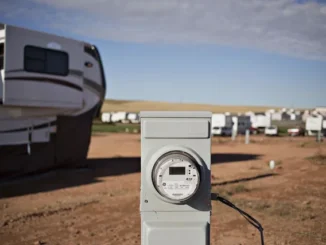
Rivers running black through the waters of the Amazon; dying animals covered in petroleum; children whose heads and bodies ache from exposure to oil; explosives buried and forgotten in Indigenous territories. The Amazon jungle — the world’s largest rainforest and a place described as the lungs of the world — is at risk from oil extraction projects and the spills that exploration in this region can cause.
According to the reporters behind a collaborative investigation on the impact of the oil industry in the Amazon, there have been more than 1,200 oil spills here in recent years. The Indigenous populations, as well as the flora and fauna of the jungle, suffer direct consequences on a daily basis.
Stained by Oil (or in Spanish, Manchados x el petroleo) was led by Mongabay Latam, part of the nonprofit Mongabay environmental news site. Reporters for the project found failures on the part of the authorities to deal with perpetrators and prevent spills in Peru, Colombia, Bolivia, and Ecuador — four countries whose borders extend into the rainforest.
Andrea Arzaba, Spanish-language editor for GIJN, interviewed Alexa Vélez, managing editor of Mongabay Latam and the lead coordinator of the investigation. During the conversation, Vélez delved into challenges of running a cross-border investigation in the region, where they obtained their data, and how they reported on the impact in hard-to-reach communities.
GIJN: Tell us about the investigation and what it was about?
Alexa Vélez: Stained by Oil was a transnational investigation coordinated by Mongabay Latam, involving media partners from Bolivia, Colombia, Ecuador, and Peru. The project enabled us to establish the magnitude of the impact of the oil industry in the Amazonian regions of these four countries, to demonstrate the absence of adequate state oversight, and to show the serious impacts on Indigenous communities.
GIJN: What were your main findings?
AV: One of the most important findings was the lack of transparency of the environmental authorities when providing information. In the case of Colombia, they only provided official data on companies sanctioned in one region — Orinoco. Though the Ecuadorian government stated that 1,202 oil spills were registered between 2011 and June 2021, officials did not provide the list of those responsible. In Bolivia, the authorities did not even respond.
Despite that, the information gathered from Peru and one Colombian region allowed us to reveal a worrying picture: there have been at least 282 sanctions against 16 companies in Peru and 56 in Colombia. The authorities have imposed 169 fines [for environmental damage] against 36 oil companies operating in the Peruvian Amazon and the Colombian Orinoco, a sum that exceeds US$55 million.
GIJN: Why was a journalistic investigation of the oil impact on the Amazon relevant?
AV: In the last four decades, more than 400 oil spills have been reported in the Peruvian Amazon. In the case of Ecuador, the Ministry of Environment, Water, and Ecological Transition says there have been more than 1,000 spills in the last decade. In Colombia, the NGO Crudo Transparente counted more than 50 spills between 2017 and 2021. In Bolivia, the authorities’ secrecy makes records impossible to obtain. Because of these figures, we thought that we needed an investigation to establish the magnitude of the impact of oil activity in the area.
GIJN: What were the biggest challenges in reporting and editing the investigation?
Vélez: The biggest challenge was building the two databases. In the case of the one gathering details on sanctions and fines, it was difficult to access information that should be publicly accessible. We had to review more than 200 files with data that needed to be standardized, and consider the differences in each country.
With the editing, the challenge was to ensure that all the information in the articles flowed to create a conversation: ensuring that there was a direct relationship between the findings of the databases and the cases we were reporting on, since these give color, or a face and a voice, to the figures.
GIJN: What environmental impacts have resulted from these spills?
AV: Water, soil, and flora were the areas most impacted by oil spills in Peru’s Amazon and Colombia’s Orinoco region. Also, the most common environmental damage in Peru was caused by oil spills following tank overflows or pipeline leaks. In Colombia, oil spills have affected rivers, watercourses, and surface or groundwater, but problems have also been detected in wastewater discharges.
We mustn’t forget that these environmental impacts seriously affect the Indigenous people living in the areas that have been contaminated. To understand the magnitude of this problem, we constructed a map to analyze how significant the overlap is between oil fields and Indigenous territories, and which allows us to paint a somewhat overwhelming picture in terms of what is happening in all four countries.

GIJN: Tell us more about the research methodology.
AV: The questions that were the starting point for our research were: What is the magnitude of the environmental impact of the oil companies in the Amazon? Have these firms been sanctioned for multiple or continuous oil spills?
From the beginning, we planned two axes of analysis: the degree and effectiveness of state oversight of this industry, and how oil concessions overlap with Indigenous territories and protected areas. For the first, we asked public institutions in the four countries for fines and sanctions imposed against oil companies operating in the Amazon between 2011 and 2021. For the latter, geospatial analysis of the territory was carried out, of 2,652 communities and 305 protected areas.
The work took a little over five months. We gathered a journalistic team from the media site Rutas del Conflicto and Cuestión Pública from Colombia, La Barra Espaciadora from Ecuador, and El Deber from Bolivia. In addition, we added experts in database construction, geospatial analysis, visualizers, audiovisual producers, and illustrators. A total of 25 people participated in the investigation.
GIJN: How did you go about requesting information from the authorities?
AV: We sent requests for information to 10 public institutions, in addition to requests for clarification, new requests, and constant calls, which was what in the end allowed us to build a database with the information received over two-and-a-half months.
Our final analysis suggests that there is no transparency from Ecuador, Bolivia, or Colombia to reveal the quality and effectiveness of their audits of oil companies, despite serious accusations that exist in their countries about constant spills and environmental impacts. Furthermore, experts maintain that the fines applied in the countries that did provide us with information no longer dissuade oil companies from causing damage and have become “a cost of doing business.”
Finally, once we had gathered the information we needed, journalists traveled to remote communities in the four countries’ Amazonian regions to listen to the testimonies of those who live alongside the oil industry. The coverage includes interviews with Shipibo, Inga, Tacana, Siona, Nasa, Kichwa, Quechua, Kukama, Wampís, and Achuar communities.

GIJN: Once you had the results, how did you present the information in the story?
AV: With the results we were able to build two multimedia tools, freely accessible, that now allow users to explore the background of the oil companies on a map and through a search engine. The tools cover the last 10 years and each case can be explored with all the specific details behind the sanctions we recorded, or the fines that have been imposed.
We also built maps to show the overlap between oil lots and Indigenous territories and protected areas. On these maps, it’s possible to search the names of the affected communities or reservations and the names of each protected area.
The investigation resulted in 16 stories. The first ones covered relevant cases stemming from complaints of environmental malpractice against oil companies. Then, after analyzing the database, we detected six key stories connected to the most-sanctioned companies, or those that had serious problems of overlap with Indigenous territories or protected areas.
GIJN: How did you conduct geospatial analysis and what did you find by using these tools?
AV: We obtained the official geographic coordinates of all Indigenous communities land titles in the Amazonian region of the four countries, and of the active oil lots. We collected this information from each of the experts in Bolivia, Colombia, Ecuador, and Peru who have contributed to constructing maps for RAISG (the Amazon Network of Georeferenced Socio-Environmental Information). An expert in geospatial analysis helped us translate the maps into excel databases to cross-reference the two layers of information. This process allowed us to establish that, in the four countries, there are 1,647 Indigenous territories and 52 protected areas overlapping with oil fields.
This information allowed us to detect specific cases where the environmental impact or the overlap with an oil company had seriously affected the communities’ life.
GIJN: What lessons learned from doing collaborative work of this type can you share with our audience?
AV: It is important to send requests for information early. Also, send parallel requests to all the institutions that may have the data. It is not enough to wait for a response from an institution; you will need to find a contact in the communications offices and sometimes to have a lawyer in the team to insist on responses to requests. At the same time, I recommend looking for data from environmental organizations mapping the issues you’re interested in investigating. They often may have information that will help understand the problem in the face of the states’ lack of response.
I always recommend that the information obtained from the databases be crosschecked with experts on the subject to ensure that the figures and the information obtained and analyzed are correct. This may also prompt suggestions or recommendations on the findings.
GIJN: What security protocols did you have when doing the research?
AV: For these types of stories, where large companies are involved, the bigger risk comes from the legal realm. Many companies tend to send notarized letters or criticize the journalist or media outlet when they do not agree with the information published. Because of this, I recommend being particularly careful in reviewing the stories, having two to three levels of editing, and, in the most complicated cases, having a lawyer who can review the articles, and being careful with language. And finally, to insist again and again on having a comment from the companies mentioned in the investigation.
GIJN: What was the impact of the work after publication?
AV: After publication, the team was invited to present the research findings at an event attended by the UN Special Rapporteur on Toxics and Human Rights and the Special Rapporteur on Economic, Social, Cultural, and Environmental Rights. We were also summoned to present the results to the Working Group on Oil Spills of the National Coordinator for Human Rights of Peru (CNDDHH). Four regional media outlets also interviewed us about the work. Finally, after requesting a statement from the Ministry of the Environment of Ecuador about our investigation Sinchiurco is Covered in Oil [on Ecuador’s Sinchiurco Kichwa community, part of the Stained by Oil series] the ministry’s press team informed us that it had initiated “legal administrative actions for the spill.”

GIJN: What else would you like to see as a result of this work?
AV: I very much value the journalistic team that came together for this project, so I think the challenge now is to ensure that this media alliance remains united to continue monitoring the extractive industries. Stained by Oil is the starting point for other work that we are preparing now that will help us to continue shedding light on an industry that is not very well supervised in some countries, and quite opaque in others.
GIJN: Finally, what advice would you give to investigative journalists who want to investigate the environmental impact of oil companies in their countries?
AV: I think the value of building complicated databases is that in the end, when you manage to gather relevant information and organize it visually, it provides a sea of possibilities to tell stories that have not yet been told. Behind those 282 sanctions and 169 fines, there are companies that have to be held accountable; behind those 1,647 Indigenous territories and 52 protected areas affected by oil lots that overlap their territories, there are socio-environmental conflicts that have not yet been told. So, my advice is that we go back to these data repositories because there are many cases that have been left pending, that need to be exposed and worked on with great rigor. It is not enough to gather information: we must continue to investigate each case.



